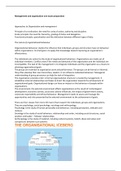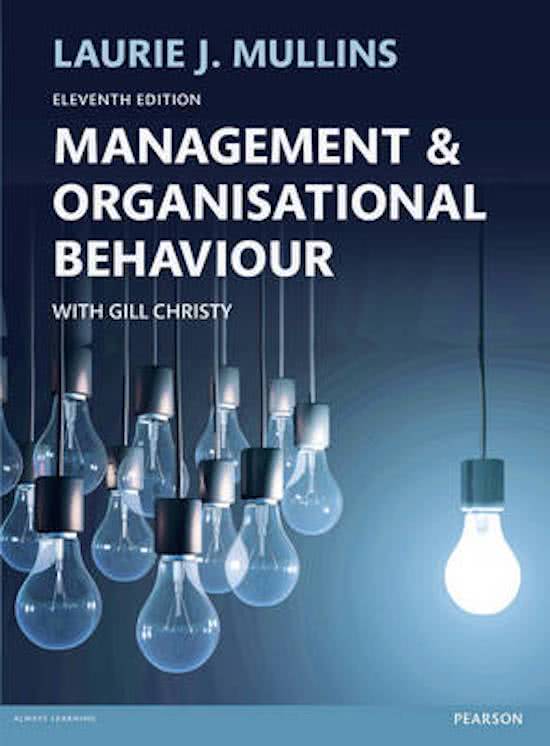Management and organization one exam preparation
Approaches to Organization and management
Principle of co-ordination: the need for unity of action, authority and discipline.
Scalar principle: the need for hierarchy, grading of duties and delegation.
Functional principle: specialisation and the distinction between different types of duty.
The nature of organizational behaviour
Organizational behaviour studies the influence that individuals, groups and structure have on behaviour
within organizations. Its chief goal is to apply that knowledge toward improving an organization’s
effectiveness.
The individuals are central to the study of organizational behaviour. Organisations are made out of
individual members. Conflict arises if the needs and demands of the organisation and the individual are
incompatible. The task of the management is to integrate individuals and the organisation as a means to
attaining organisational goals.
The groups are essential to organisation work and performance. The groups can be formal or informal;
they often develop their own hierarchies, leaders. It can influence individual behaviour. Managerial
understanding of group processes can help the task of integration.
The organization provides order. A formal organisational structure is created by management. It
establishes internal relationships and helps to direct the organisation towards the achievement of
organisational goals. Organisational design can have an impact on the behaviour of people within
organisations.
The environment, the external environment affects organisations as the result of: technological
development, economic activity, social and cultural influences, the impact of government actions,
corporate responsibility and ethical behaviour. Management needs to assess and manage the
opportunities and risks presented by the external environment to the achievement of goals.
There are four classes from micro till macro that research the individuals, groups and organizations.
They are psychology, social psychology, sociology and anthropology.
Psychology is the study of human personality and behaviour, including perception, attitudes and
motives.
Sociology is the study of social behaviour, relationships and order, including social structures, social
position and leader – follower relationships.
Anthropology is the study of mankind, including cultural systems, beliefs, ideas and values and
comparisons between such systems.
1
,The social exchange theory: people generally enter into a relationship with others with the expectation
of some kind of mutually acceptable exchange. Exchanges are subject to a ‘cost-benefit’ analysis. It’s
about the importance of actual (or perceived) reciprocity in determining attitudes and behaviours at
work.
The psychological contract: a series of mutual expectations and satisfaction of needs arising from the
people-organizational relationship. Rights, privileges, duties and obligations which are not part of a
formal agreement, but have an important influence of behaviour.
The Peter Principle: In a hierarchy every employee tends to rise to their level of incompetence.
Parkison’s law: work expands to fill the time available for its completion.
Trompenaars’ framework for analysing cultural differences:
Universalism versus particularism
Individualism versus collectivism
Neutrality versus emotion
Diffuse versus specific relationships
Achievements versus ascription
Future versus past orientation
Attitude to the natural environment
The diversity in workforce brings some implications. Managers have to shift their philosophy from
treating everyone alike to recognizing differences and responding to those differences in ways that
ensure employee retention and greater productivity while, at the same time, not discriminating.
Individual differences and diversity
An individual’s behaviour is influenced by the person self; skills and abilities, personality, perceptions,
attitudes, values and ethics. And also by the environment through the organization, work group, job and
personal life.
Personality may be defined as stable characteristics that explain why a person behaves in a particular
way. ‘Stable’ because it is a consistent part of an individual’s behaviour. Characteristics could include:
independence, conscientiousness, agreeableness, self control, etc.
2
, Personality is most often described in terms of measureable traits that a person exhibits, such as shy,
aggressive, submissive, lazy, ambitious, loyal and timid.
Heredity is proven to be the most dominant factor in personality determinants, so genetics are more
influential than parents. Though environmental factors do have some influence. Aging influences the
levels of ability, while the basic personality stays constant.
The myers-briggs type indicator (MBTI) is the most widely used instrument in the world. Participants are
classified on four axes to determine one of 16 possible personality types, such as ENTJ. Each possible
outcome has a name. It is a good tool for self-awareness and counselling.
The big five model of personality dimensions:
Extrovision - Sociable, gregarious and assertive
Agreeableness - Good-natured, cooperative, and trusting
Conscientiousness - Responsible, dependable, persistent, and organized
Emotional stability - Calm, self-confident, secure under stress
Openness to experience- Curious, imaginative, artistic, and sensitive
Friedman and Rosenman: type a and b personalities:
Type A is aggressively involved in a chronic, incessant struggle to achieve more in less time. He is
impatient: always moving, walking, and eating rapidly. Strives to think or do two or more things at once.
Type B is the complete opposite. He has a proactive personality, can identify opportunities, shows
initiative, takes action, and perseveres to completion. He creates positive change in the environment.
3





